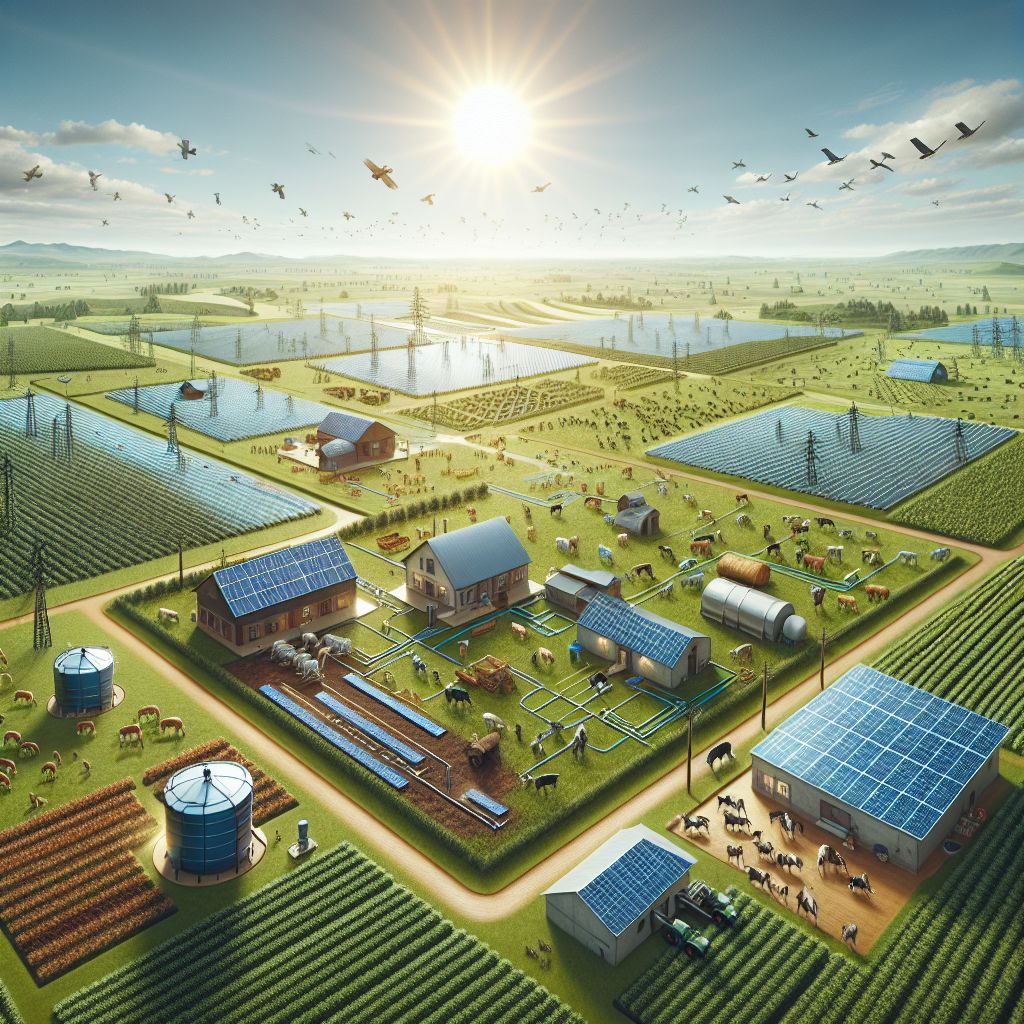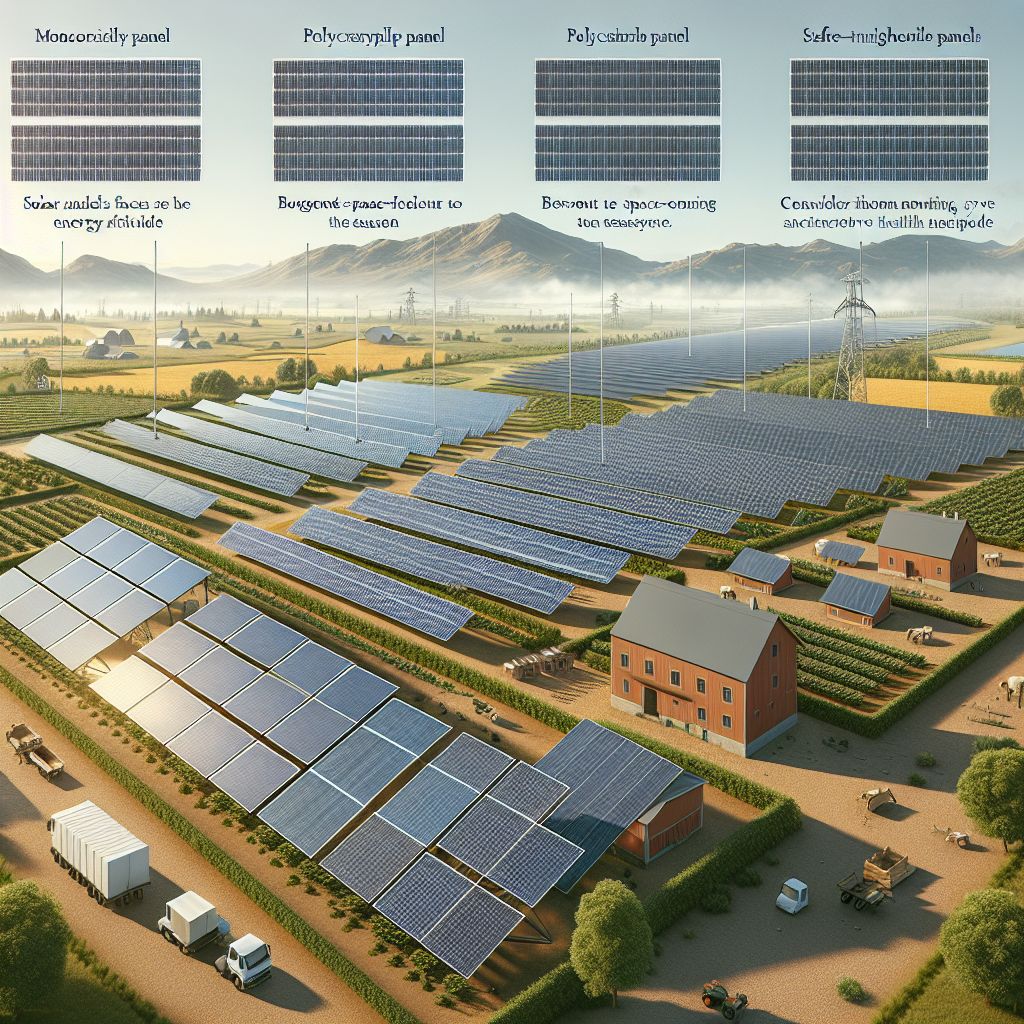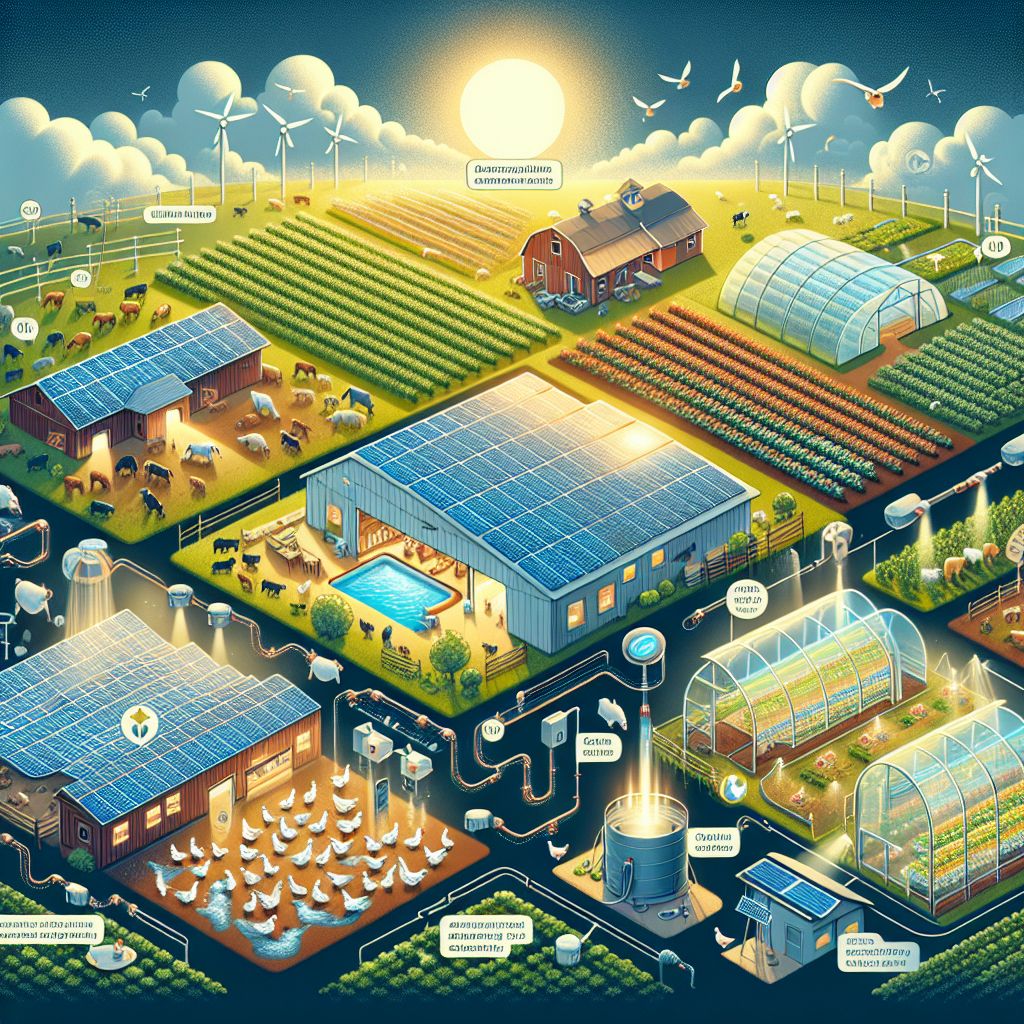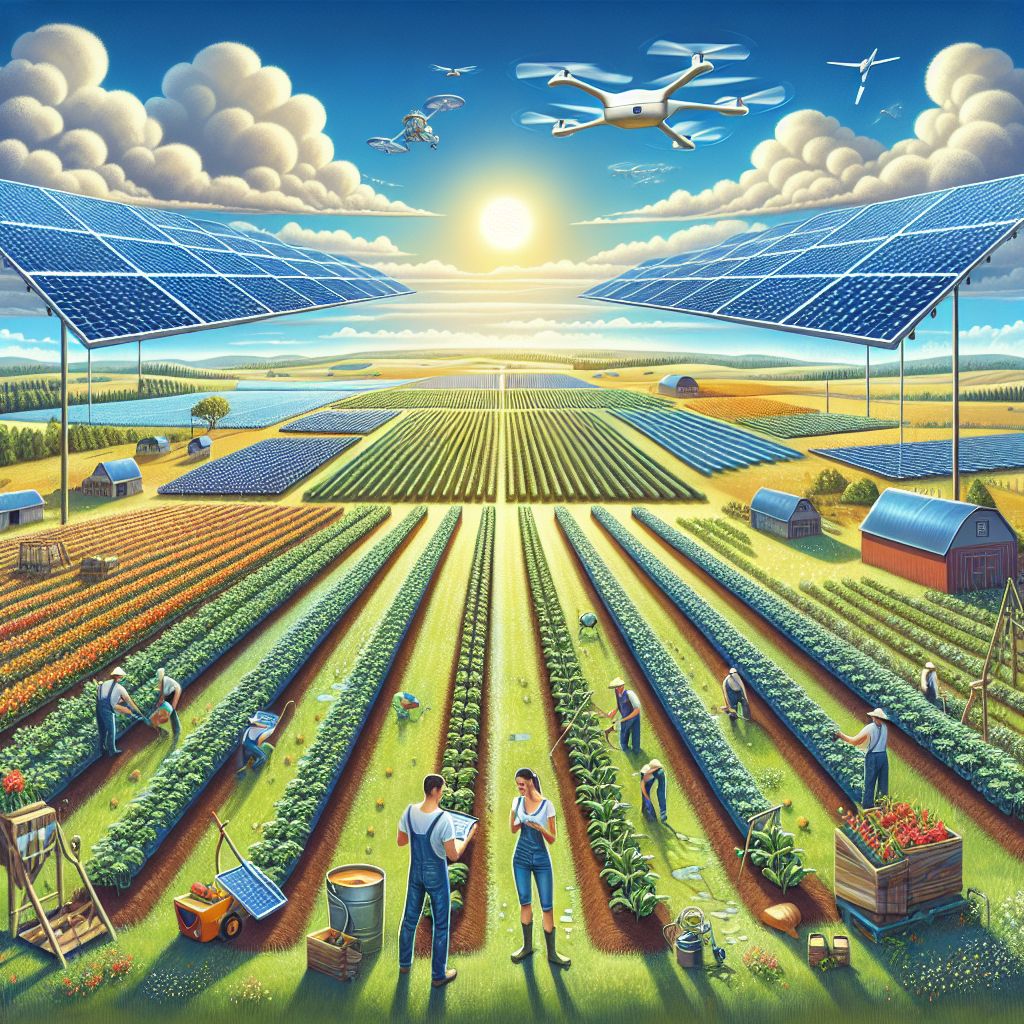
Key Takeaways
Farms can greatly reduce their energy bills with solar panels.
Selecting the right solar panel is key to getting the most energy efficiency.
Properly positioning solar panels can boost the amount of energy they capture and their overall effectiveness.
Solar energy can power everything from water pumps to livestock facilities on farms.
Storing solar energy in batteries can ensure farms have power even when the sun isn’t shining.
Converting Sunlight into Cost Savings and Sustainability
Picture a farm where the energy required to pump water, illuminate barns, and operate machinery comes directly from the sky. This is not a vision of the future—it’s a reality that can be achieved with solar panels. Solar energy captures the sun’s power to produce clean, renewable energy, reducing utility bills and decreasing dependence on fossil fuels. The move to solar is not just about saving money; it’s about committing to sustainable farming methods that can help protect the environment for future generations.
How Solar Power Is Revolutionizing Farming
Any farmer will tell you that farming isn’t just about growing crops or raising animals. It’s also about managing resources, and one of the most important resources is energy. Farms use a lot of it, and it’s usually pretty expensive. That’s where solar power comes in. By installing solar panels, farms can generate their own electricity. This can lead to huge savings over time. Plus, solar power is clean, so farms can reduce their carbon emissions while they generate power.
In addition, solar panels are now more accessible than ever before, thanks to technological advances and government incentives. This means that even small farms can now consider solar power as a viable option. And we can’t overlook the benefit of energy independence. With solar panels, farms are not at the mercy of power outages or fluctuating energy prices. They can generate their own power when the sun is shining and store excess energy for use during cloudy days or at night.
“Although transitioning to solar energy may seem daunting, the enduring cost savings and ecological advantages make it a worthwhile investment for any farm.”
Achieving Energy Self-Sufficiency
There’s something quite empowering about energy independence, especially for farmers who are all too familiar with the unpredictability of both nature and the markets. Solar panels allow farms to generate their own energy, giving them control over a vital part of their operation. But it’s not just about self-sufficiency, it’s about resilience too. A farm that can generate its own power is less susceptible to external disruptions, whether they’re natural disasters or economic fluctuations.
How can a farm become energy independent? The first step is to assess the farm’s energy needs and determine the appropriate size and number of solar panels to meet those needs. The next step is to install a solar energy system that is designed to capture and store as much energy as possible. The final step is to maintain and optimize the system to ensure that it operates efficiently throughout the year. By following these steps, farms can transform their solar power systems into reliable power sources that can support all of their operations.
Primarily, this shift towards energy self-sufficiency via solar energy is in line with the principles of environmentally aware farmers. It’s a move towards building a farm business that is not just profitable but also accountable and innovative.
“A farm equipped with solar panels is not just a food production site, it’s a pledge to a more sustainable and improved future.”

Highlighting Energy Efficiency in Agriculture
Selecting the Appropriate Solar Panel
Solar panels are not a one-size-fits-all solution. The type of solar panels you choose can greatly impact how much energy your farm can produce. There are a variety of solar panels on the market, each with their own advantages and disadvantages. Monocrystalline panels, for example, are very efficient and compact but are also more expensive. Polycrystalline panels are a more budget-friendly option but are not quite as efficient. Thin-film panels are flexible and inexpensive but require more space and don’t last as long.
Deciding on the perfect panel relies on a variety of factors, such as the energy requirements of the farm, the climate, available space, and budget. It’s crucial to conduct in-depth research or seek advice from a solar energy professional to make a knowledgeable choice. The correct decision will guarantee that the solar panels supply the highest energy output for the unique conditions of the farm.
Intelligent Design Selections for Optimal Production
After you’ve decided on the kind of solar panel you want to use, the next step is to strategically design your solar array. This involves thinking about the orientation and angle of the panels so they can soak up as much sunlight as possible all year round. For instance, if your farm is in the northern hemisphere, your solar panels should generally be facing south to get the most sunlight. You should also adjust the tilt angle based on your farm’s latitude to make sure the panels work as efficiently as possible in different seasons.
Besides positioning and angling, it’s also important to avoid shading. Even a bit of shade can drastically decrease the energy production of solar panels. So, it’s key to put solar arrays in places where tall trees or buildings won’t cast shadows, particularly during the hours of most intense sunlight.
Lastly, think about the infrastructure required to support the solar panels. This involves mounting systems that can endure local weather conditions and wiring that carries the electricity generated safely and efficiently. By focusing on these design details, farms can make sure that their solar panels work at maximum efficiency and contribute to a more sustainable operation.

Uses That Yield More Than Just Produce
Various Applications for Solar Panels on Farms
Solar panels on a farm can do much more than just lower the electricity bill. They can power a wide range of applications that are essential to farm operations, such as high-efficiency irrigation systems for sustainable agriculture. Here are a few ways solar energy can be put to work:
Water pumping: Solar panels can be used to power pumps that bring water to the fields for irrigation or to troughs for animals.
Lighting: Solar energy can provide the necessary lighting for barns and greenhouses without relying on the grid.
Electric fencing: Solar energy can be used to power electric fences, keeping animals safe and contained.
Greenhouse heating: Solar panels can also be used to maintain the temperature of greenhouses, which is crucial for crop growth during colder months.
The table below will show some more ways solar energy can be used on farms beyond just lowering the electricity bill:
|
Application |
Description |
|---|---|
|
Irrigation Systems |
Solar-powered irrigation systems can provide efficient water delivery for crops, reducing water usage and costs. 1, 2 |
|
Livestock Watering |
Solar-powered water pumps can supply clean drinking water for livestock, improving animal health and productivity. 1, 2 |
|
Barn/Shed Lighting |
Solar panels can power lighting in barns, sheds, and other farm structures, improving visibility and safety. 1, 2 |
|
Electric Fencing |
Solar-powered electric fencing helps contain livestock and protect crops without relying on the grid. 1, 2 |
|
Crop Drying |
Solar thermal energy can be used to dry crops after harvest, reducing energy costs compared to traditional drying methods. 1, 2 |
|
Greenhouse Heating |
Solar thermal energy can heat greenhouses, extending the growing season and reducing fossil fuel usage. 1, 2 |
|
Water Pumping |
Solar-powered water pumps can extract groundwater for irrigation, livestock, and other farm uses. 1, 2 |
|
Machinery Charging |
Solar panels can charge batteries for farm equipment like ATVs, tractors, and other vehicles. 1, 2 |
These applications show the versatility of solar power on farms. It’s not just about replacing traditional electricity; it’s about improving the overall functionality and efficiency of the farm.
Charging Chickens: Solar Energy in Livestock Management
While solar energy is often associated with electricity generation for homes and businesses, its use in agriculture, specifically in livestock management, is gaining traction. Incorporating solar panel trackers on farms can significantly enhance the efficiency of operations, including providing a sustainable energy source for powering equipment used in managing and charging chickens.
Managing livestock needs a steady source of power, particularly for maintaining temperature and lighting in chicken coops. Solar panels offer a dependable and economical way to power these energy-demanding tasks. By tapping into solar energy, farms can keep their livestock habitats well-managed, a key factor in keeping animals healthy and productive.
For instance, a chicken farm that adopts solar energy can keep ideal light conditions to facilitate the chickens’ growth stages without the stress of the price or ecological effect of conventional power sources. This enhances the farm’s sustainability and can even result in healthier chickens and, consequently, superior yields.
Going Green: Solar-Powered Irrigation
Solar panels can also make a big difference in irrigation. Water is a vital resource, and efficient irrigation is crucial for sustainable farming. Solar-powered water pumps can provide water to crops without the need for diesel generators or grid electricity. This not only saves money but also reduces emissions and the farm’s carbon footprint.
In addition, solar-powered irrigation systems can be integrated with smart technology. Sensors can measure soil moisture levels and activate irrigation only when necessary, avoiding water waste and making sure crops get the right amount of water at the right time. This smart application of solar power not only saves water but also makes crops healthier and more productive.
Using solar power for these important uses allows farms to be more sustainable and efficient. This can lead to long-term success and resilience in a constantly changing agricultural environment.

Getting the Most Out of Your Farm’s Solar Panels
You’ve got your solar panels installed, but are you really harnessing the sun’s power to the fullest? It’s not enough to just have them—you’ve got to make sure they’re soaking up as much sunshine as possible, every single day. Let’s explore how you can maximize the energy output from your solar panels.
Positioning Your Panels: The Angle of Incidence
Point the panels true south (if you’re in the northern hemisphere) to maximize sun exposure.
Adjust the tilt angle according to your latitude for the optimal angle throughout the year.
Ensure your panels are free of shade, particularly during the sun’s peak hours.
Correct positioning means your panels will soak up the sun’s rays in the best way, allowing them to generate more power. Consider it like sunbathing—you’d position your panels like you’d position your beach chair, aiming for the perfect tan.
Just a friendly reminder, the sun moves throughout the year, so it might be a good idea to get an adjustable mounting system. This way, you can change the angle of your panels to match the summer sun and the winter light, ensuring you always get the most out of your panels.
However, it’s not just about the sun’s position. You also need to consider the surroundings of your panels. Shadows cast by trees, buildings, or even occasional passing clouds can reduce your power. Keep an eye out and make sure nothing obstructs your solar absorption.
Stay Tidy: Maintenance for Optimal Performance
Grime, dust, foliage, even bird feces—anything that covers your panels can obstruct the sun and reduce your power output. It’s akin to trying to see through a grimy window; you must keep it clean to see properly. Thus, consistently inspect your panels and clean them gently to maintain their optimal sun-absorbing capacity.
However, caution is required—you do not want to scrape or harm the panels. Employ a gentle brush or rag and some clean water to remove any dirt. Refrain from using strong chemicals or pressure washers; handle them as if they were a luxury car.
“Think of regular cleaning as a check-up for your solar panels. Keeping them clean keeps them efficient, and that equates to more power for your farm.”
While you’re up there, inspect for any signs of damage. Look for cracks, loose connections, or anything that seems out of place. Addressing a minor issue early can prevent a major problem (and expense) later on.
Combining Solar Panels with Crop Monitoring Systems
Let’s get technical. Solar panels are fantastic by themselves, but when you combine them with smart farming tools, you create an unbeatable team. We’re talking about sensors that monitor soil moisture, drones that watch over the health of your crops, and systems that alert you when it’s time to water, fertilize, or harvest.
When you link your solar panels to these intelligent systems, you’re doing more than just supplying energy to your farm; you’re also equipping it with a brain. It’s as if you have an incredibly clever farm worker who’s always alert, ensuring that your crops receive exactly what they require at exactly the right time.

Make the Most of Your Day: Optimizing Solar Power from Dawn to Dusk
When you’re working with solar energy, it’s crucial to take full advantage of every second of sunlight. From the first light of daybreak to the final rays of sunset, your panels should be hard at work, absorbing sunlight and converting it into energy for your farm.
Tracking Technology: Keeping Up with the Sun
Similar to how sunflowers rotate to face the sun, some solar panels have the ability to do the same. These panels are equipped with motors and sensors that follow the sun’s path across the sky, ensuring your panels are always at the optimal angle. This is a clever piece of technology that can significantly increase your energy production.
However, these tracking systems come with a higher initial cost and require maintenance due to their moving parts. So, you have to consider the advantages and disadvantages. More power comes with more cost and care—it’s a balance you have to find based on your farm’s needs and budget.
Battery Solutions: Harnessing Solar Power for Use After Dark
While the sun may retire at sundown, your farm’s operations don’t. That’s where batteries come into play. They accumulate the solar energy generated throughout the day, ensuring that you can continue to power your lights and machinery long after the sun has set.
Consider batteries as water tanks. In the same way you store water for dry periods, you store power for dark times. And similar to water tanks, you need to have sufficient storage to cater to your needs. If it’s too small, you’ll run out; if it’s too large, you’ll have excess. It’s crucial to find the right size for your farm.
Remember, batteries require maintenance as well. Ensure they are kept at the correct temperature, monitor their charge, and replace them when they become depleted. Proper battery care ensures a consistent power supply, both day and night.
Case Studies: Farms Flourishing with Solar Power
Farms worldwide, regardless of their size, are enjoying the advantages of solar power. From vineyards in California to dairy farms in New Zealand, solar panels are assisting farmers in reducing costs, decreasing emissions, and managing their energy needs. Here are a few bright examples.
Case Study 1: Small Farm, Big Savings
Consider the tale of a small family-owned farm located in the Midwest. They made the decision to go green by installing solar panels to power their irrigation system, barn lights, and feed equipment. The money they saved on their energy bill was reinvested into their crops and livestock. And the cherry on top? They’ve significantly reduced their carbon footprint, making their farm environmentally friendly in more ways than one.
This is a prime example of a smart investment leading to significant returns. But it’s not just about the money. It’s about demonstrating that sustainable farming is possible and that even small farms can make a big impact.
Final Thoughts: Are Solar Panels Worth It for Farmers
So, after all that, are solar panels worth it for farmers? The answer is a big yes. Solar panels provide a renewable energy source that can greatly lower operating costs over time. Even though the initial cost can be high, the long-term savings, environmental advantages, and energy independence make solar panels a smart choice for farmers who are dedicated to sustainability and want to secure their operations for the future.
Common Questions
It’s understandable to have queries when you’re thinking about making a big switch in your farm’s energy supply. Here are a few of the usual questions that farmers have when they’re thinking about switching to solar power:
What are the initial steps to converting my farm to solar power?
The initial steps to converting your farm to solar power are:
Completing an energy audit to get a clear picture of your current energy usage and needs.
Researching local solar installers and getting multiple quotes to compare options.
Looking into financing options, including loans, leases, and government incentives.
Choosing the right size and type of solar panel system for your farm’s specific requirements.
Working with a trusted installer to design and install the solar panel system.
It’s very important to start with a clear understanding of your energy needs and to work with professionals who can guide you through the process, ensuring that your transition to solar power is smooth and successful.
How Can I Figure Out How Many Solar Panels My Farm Needs?
In order to figure out how many solar panels your farm needs, you have to figure out how much energy you use on average. This information can be found on your utility bills. Once you know how much energy you use, you can work with a solar installer to design a system that will meet your needs. They will take into account things like how many hours of sunlight your area gets, how efficient the panels are, and how much space you have on your farm for the solar array.
Is it Possible for Solar Panels to Power Large Farm Machinery?
Yes, solar panels can power large farm machinery, but it really depends on the energy needs of the equipment and the capacity of your solar panel system. For equipment that uses a lot of energy, you might need a bigger solar array or a hybrid system that uses solar power in combination with other energy sources. It’s a good idea to talk to a solar energy expert to get a better understanding of what’s possible and what changes you might need to make for your particular situation.
What is Agrivoltaics and How Can It Improve My Crop Production?
Agrivoltaics is the simultaneous use of land for both solar photovoltaic power and agriculture. This modern method can improve crop production by:
Providing shade to lessen heat stress on plants, which can improve growth.
Reducing water evaporation from the soil, leading to more efficient water usage.
Creating a microclimate that can extend the growing season for certain crops.
Using agrivoltaics can make land use more sustainable and improve overall farm productivity.







Leave a Reply